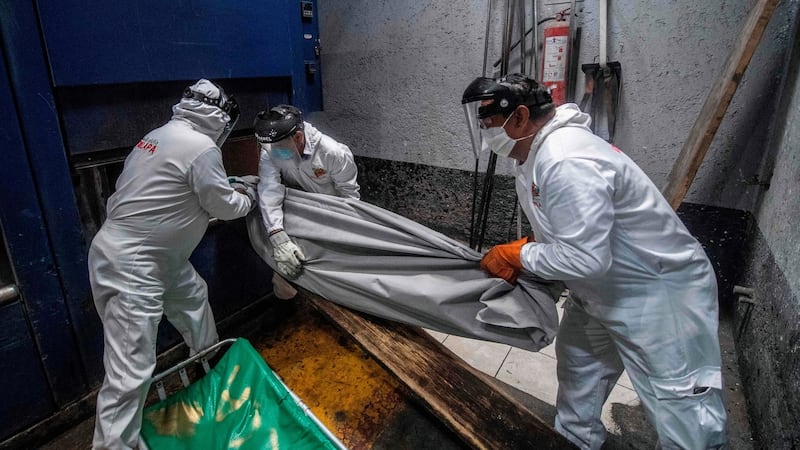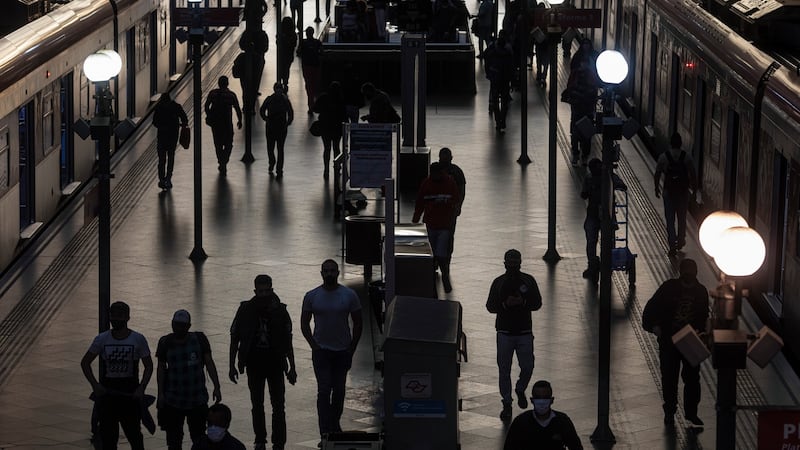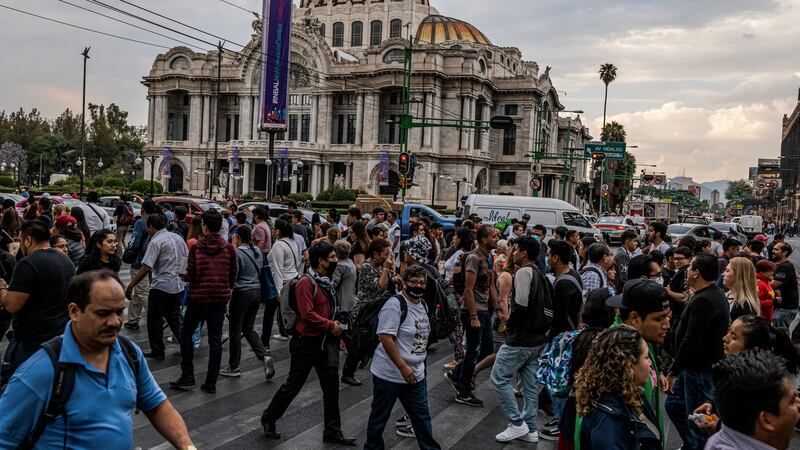By late March, the Mexican government calmly predicted that its coronavirus outbreak would peak in April. A few weeks later, it changed its prediction to mid-May. And then to late May. And then to June.
Now, with new infections surging and the government facing growing anger, even ridicule, over its constant guesswork, many Mexicans have drawn their own conclusion: No one really knows.
"Obviously, prediction is not a guarantee of precision," Hugo Lopez Gatell, the federal health official in charge of the nation's virus response, has acknowledged.
Mexico, like the rest of Latin America, has quickly become a focal point of the pandemic, a worrisome frontier for a virus that has claimed the lives of more than 460,000 people and infected more than 9 million worldwide.
The coronavirus was always going to hit Latin America hard. Even before it arrived, experts warned that the region’s combustible blend of inequality, densely packed cities, legions of informal workers living day-to-day and health care systems starved of resources could undermine even the best attempts to curb the pandemic.
But by brushing off the dangers, fumbling the response, dismissing scientific or expert guidance, withholding data and simply denying the extent of the outbreak altogether, some governments have made matters even worse.

Months have passed since the pandemic struck Latin America, but unlike in parts of Asia, Europe and the hardest-hit cities in the United States, the virus is only gaining steam across the region. Deaths have more than doubled across Latin America in a month, according to the Pan American Health Organization, and the region now accounts for several of the world's worst outbreaks.
In recent weeks, Brazil has often recorded the world's highest number of new infections and daily deaths – and shows no signs of slowing down. Peru and Chile now have more cases per capita than the United States. Cases continue to climb in Mexico, which recently became one of the few countries anywhere to hit 1,000 deaths or more in a single day.
Civil rights
And as the virus storms through the region, corruption has flourished, the already intense political polarisation in some countries has deepened, and some governments have curtailed civil rights. In El Salvador, thousands of people have been rounded up, many for violating stay-at-home orders, despite the supreme court's demands that the detentions end.
Economies already stretched thin before the virus lie on the precipice of ruin. Millions are out of work, with millions more at risk. The United Nations has said the pandemic could result in a drop of 5.3 per cent in the regional economy – the worst in a century – forcing some 16 million people into extreme poverty.
“In a matter of months, we could lose what we have gained in 15 years,” said Julio Berdegué, the regional representative for the Food and Agriculture Organization of the United Nations.
In Brazil, where President Jair Bolsonaro spent months downplaying the threat of the virus – calling it a "measly flu" and railing against shutdowns imposed by governors – epidemiologists say the death toll could surpass the total in the United States to become the world's highest by late July.
In Mexico, where President Andrés Manuel López Obrador has suggested that a clean conscience helps ward off infection – “no lying, no stealing, no betraying, that helps a lot to not get coronavirus”, he recently told reporters – the country has already suffered three times as many deaths as officials first predicted.
Not all is dire in the region. Nations like Uruguay and Costa Rica seem to have avoided the worst so far, while an almost military-style health care intervention in Cuba has left the island nation in better standing than most.
But in much of Latin America, the worst may still be on its way. Colombia is entering its harshest recession since record-keeping began more than 100 years ago. Venezuela has tumbled into freefall. Ecuador is facing a debt crisis and a return of mass social unrest. Peru has gone from projecting the region's fastest economic growth to one of its worst contractions.
In some South American nations, such as Chile and Colombia, the cases are just beginning to surge. In Argentina, which enforced strict, successful quarantine measures, a fresh outbreak, largely in the Buenos Aires metropolitan area, has troubled officials. The number of cases has more than quadrupled in the past month, while deaths have more than doubled.

“We’re doing well because of everything we did, but there is a real possibility that the increase in cases will turn into a problem that is difficult to manage,” said Ginés González García, Argentina’s health minister.
Commonalities
Latin America has a vast array of distinct politics, cultures, geographies and histories. But some commonalities may help explain why, despite at least a month of advanced notice that the virus was on its way, many countries struggled to buffer the blow.
Regionwide, 53 per cent of workers are estimated to toil in the informal sector, selling food on the streets, working in part-time construction jobs or cleaning the homes of wealthier families. Many live in densely crowded parts of the region’s largest cities, in neighbourhoods where sanitation is poor and access to fresh water is limited. By and large, they have no paycheques, no pensions, no insurance, no benefits.
For many, to quarantine is to starve. "If I can't work, I can't eat, it's as simple and plain as that," said Mario Muñoz Cruz, a shoe shiner in Mexico City. "If the doctors and experts tell me to stay home, I would ask them, 'What do I eat then?'"
While there is a seemingly democratic quality to the virus – it can infect anyone, including leaders like the president of Honduras, Juan Orlando Hernández – it follows and exploits the disparities that already divide the region.
Risk factors like diabetes, hypertension and obesity are generally higher among the poor. And while the wealthy can afford private hospitals, the poorest rely on public health systems plundered by years of neglect. On average, nations in the region spend about a quarter of what developed nations spend each year on health.
Even in nations where the response was arguably exemplary, like Peru, endemic poverty overwhelmed the best intentions. Now the country is fighting one of the world’s worst outbreaks – and the economic consequences.
Delmira Vasquez (36) moved to the capital, Lima, in early March, like many Peruvians from poorer provinces who have seen their hopes vanish in the pandemic. Her husband, a construction worker, found a job within a week of arriving in Lima, but lost it the week after because of the strict national lockdown that shut down most activities.
“Now we only eat because our neighbours take pity on us,” Vasquez said from the one-room shack on a hillside shantytown that she shares with her husband and three children.
Rural areas
Rural areas have hardly been spared, either. In the small Colombian city of Leticia, along the Amazon River, the recorded death rate is nearly 28 times as high as for the country as a whole, according to government data.

"The situation is incredibly grave," said Dr Mauricio Diaz, who works in Leticia and described his hospital as "a parody" of a hospital. A few days ago, he said, four ventilators arrived. But the hospital's wall outlets are broken, and "we haven't been able to use them", he said.
The degree of suffering endured by some nations was not inevitable, experts say, pointing to Brazil, Mexico and Nicaragua for particularly poor leadership during the crisis.
In Nicaragua, President Daniel Ortega rejected measures adopted worldwide to curb the spread of the virus, saying that most Nicaraguans were too poor to not work under a shutdown. Schools and businesses remained open, though hundreds of doctors across the nation urged the government to acknowledge the virus was proliferating.
In open disregard of the risks, the government organised a rally, held in solidarity with countries going through the pandemic. It was dubbed “Love in the Time of Covid-19”, and was held while other nations ordered or urged their citizens to stay at home.
As the virus was tearing through Brazil and stirring widespread anger at Bolsonaro, the president, his administration made a decision that shocked health experts: It simply stopped reporting the total death toll. And while his health ministry was urging people to stay home, Bolsonaro encouraged mass demonstration and shook hands in public.
Mexico’s president, Lopez Obrador, also mocked the virus early on, continued to hug and kiss his supporters, and encouraged Mexicans to patronise restaurants until the end of March. Even his coronavirus czar, Lopez Gatell, claimed that the president’s “moral authority” would protect him from the virus, and until last month, he dismissed the utility of face masks.
"One of the fundamental lessons that is coming out of this pandemic is that governments make a difference," said Octavio Gomez Dantes, a researcher at Mexico's National Institute of Health. "The evolution of a pandemic depends in an important way on the responses of various governments."
Exception of Uruguay
With fewer than 1,000 confirmed cases and 24 deaths, Uruguay is a standout in the region. The tiny country of 3.4 million quickly enacted a system of contact tracing and, when it had only four confirmed cases, it closed borders, suspended schools and called on the population to stay home. Uruguayans listened.
“We have been able to succeed thanks to the citizens who understood the urgency and the importance of taking care of themselves and each other,” explained José Luis Satdjian, sub-secretary of Uruguay’s health ministry.
The relative success has extended the honeymoon period for President Luis Lacalle Pou, who had been in office just two weeks when the nation confirmed its first Covid-19 outbreak in mid-March.
“Uruguayans believe the government has handled this situation well,” said Mariana Pomiés, executive director of Cifra, a local polling firm. “The government has benefited from the pandemic.” – New York Times










